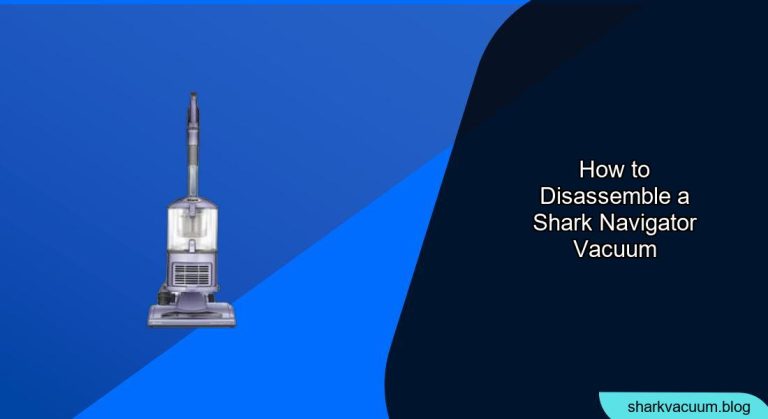Disassembling your Shark Navigator vacuum can be necessary for deep cleaning, replacing worn parts, or troubleshooting issues. While it might seem daunting, following a systematic approach makes the process manageable. This guide provides a detailed, step-by-step walkthrough on how to safely and effectively disassemble your Shark Navigator vacuum.
Why Disassemble Your Shark Navigator Vacuum?
There are several reasons why you might need to take apart your Shark Navigator vacuum. Understanding these can help you determine if disassembly is the right approach:
- Deep Cleaning: Over time, dirt, dust, and debris can accumulate inside the vacuum, reducing its efficiency. Disassembling allows you to clean these hard-to-reach areas thoroughly.
- Part Replacement: Components like belts, hoses, or filters may wear out or break. Disassembly is required to access and replace these parts.
- Troubleshooting: If your vacuum is experiencing issues like reduced suction or unusual noises, disassembling it can help you identify the source of the problem.
Table of Contents
Tools and Materials Needed
Before you begin, gather the necessary tools and materials to make the disassembly process smoother and safer. Having everything on hand will prevent interruptions and ensure you can complete the task efficiently.
- Screwdrivers: A set of screwdrivers, including Phillips head and flathead, in various sizes.
- Pliers: Useful for gripping and removing small parts.
- Soft Brush: For dusting and cleaning components.
- Small Container: To hold screws and small parts, preventing them from getting lost.
- Cleaning Solution: Mild soap and water for cleaning washable parts.
- Microfiber Cloths: For wiping down components.
Preparation Steps Before Disassembly
Before diving into the disassembly process, it’s essential to take a few preparatory steps. These measures ensure your safety and help streamline the procedure.
- Unplug the Vacuum: Always disconnect the vacuum from the power outlet to prevent electrical shock.
- Empty the Dust Cup: Remove the dust cup and empty its contents into a trash bin. Clean the dust cup with soap and water, and allow it to dry completely.
- Remove Attachments: Detach all accessories, such as the hose, wand, and any brush heads.
- Work in a Clean Area: Choose a well-lit, spacious area where you can comfortably work and keep track of all the parts.
Disassembling the Main Components
Now, let’s move on to the actual disassembly. Follow these steps to carefully take apart the main components of your Shark Navigator vacuum.
1. Removing the Hose and Wand
The hose and wand are usually the easiest parts to remove.
- Hose: Locate the hose connection point on the vacuum body. Press the release button or latch, if present, and gently pull the hose away from the vacuum.
- Wand: The wand typically connects to the hose or the vacuum body. Press the release button and detach the wand.
2. Accessing the Brush Roll
The brush roll is a key component that often requires cleaning or replacement.
- Flip the Vacuum: Turn the vacuum over to access the brush roll cover.
- Remove the Cover: Use a screwdriver to remove the screws holding the brush roll cover in place. Carefully lift off the cover.
- Remove the Brush Roll: Gently lift the brush roll out of its housing. Note the orientation for reassembly.
- Clean the Brush Roll: Remove any hair, threads, or debris wrapped around the brush roll. Scissors or a seam ripper can be helpful for this task.
3. Disassembling the Motor Housing
The motor housing contains the vacuum’s motor and other critical components.
- Locate the Screws: Identify the screws holding the motor housing together. These are usually located on the back or bottom of the vacuum.
- Remove the Screws: Use the appropriate screwdriver to remove all the screws.
- Separate the Housing: Carefully separate the two halves of the motor housing. You may need to use a flathead screwdriver to gently pry them apart.
- Access the Motor: Once the housing is open, you can access the motor and other internal components. Be careful not to damage any wires or connections.
4. Removing the Filters
Filters are essential for maintaining the vacuum’s performance and air quality.
- Locate the Filter Compartment: The filter compartment is usually located near the motor or dust cup.
- Open the Compartment: Open the filter compartment by releasing the latch or removing the cover.
- Remove the Filters: Take out the filters, noting their order and orientation.
- Clean or Replace: Clean washable filters with mild soap and water, and allow them to dry completely. Replace disposable filters as needed.
Troubleshooting Common Disassembly Problems
Even with careful instructions, you might encounter some challenges during disassembly. Here are some common issues and how to address them:
- Stuck Screws: If a screw is stuck, try using a rubber band or steel wool between the screwdriver and the screw to improve grip. You can also apply a drop of penetrating oil and let it sit for a few minutes before trying again.
- Tight Housings: If the housing is difficult to separate, check for any hidden screws or latches. Use a plastic prying tool or a flathead screwdriver to gently pry the housing apart, working your way around the seam.
- Lost Parts: To prevent losing small parts, work in an organized area and use a small container to store screws and other components. If you do lose a part, check the area thoroughly or consult the vacuum’s parts diagram to identify and order a replacement.
- Broken Components: If you accidentally break a component during disassembly, stop and assess the damage. Determine if the part can be repaired or if it needs to be replaced. Contact Shark customer support or an authorized repair center for assistance.
- Difficulty Reassembling: Take pictures or videos during disassembly to help you remember how the parts fit together. Refer to the vacuum’s parts diagram or online resources for guidance.
Tips, Warnings, and Best Practices
- Safety First: Always unplug the vacuum before disassembling it.
- Take Photos: Capture images of each step to aid in reassembly.
- Be Gentle: Avoid using excessive force, which can damage parts.
- Keep Screws Organized: Use labeled containers to keep track of screws.
- Consult the Manual: Refer to your vacuum’s manual for specific instructions and diagrams.
FAQ Section
How often should I disassemble my Shark Navigator vacuum for cleaning?
Disassemble your Shark Navigator vacuum for deep cleaning every 3-6 months, depending on usage. Regular cleaning prevents buildup and maintains optimal performance.
Can I use any type of screwdriver for disassembly?
No, using the wrong type of screwdriver can damage the screws or the vacuum. Use the correct size and type (Phillips head or flathead) for each screw.
What should I do if I can’t remove the brush roll?
Check for any obstructions or debris that may be preventing the brush roll from coming out. Use scissors or pliers to remove any tangled hair or threads.
Are all Shark Navigator models disassembled in the same way?
While the general process is similar, there may be slight variations depending on the specific model. Always consult your vacuum’s manual for detailed instructions.
How do I clean the filters properly?
Washable filters should be cleaned with mild soap and water, rinsed thoroughly, and allowed to air dry completely before reinstallation. Replace disposable filters according to the manufacturer’s recommendations.
What if my vacuum still doesn’t work after reassembly?
Double-check all connections and ensure that all parts are properly installed. Consult the troubleshooting section of your vacuum’s manual or contact Shark customer support for assistance.
Conclusion
Disassembling your Shark Navigator vacuum might seem complex, but with the right tools and a methodical approach, it’s a manageable task. Whether you’re aiming for a deep clean, replacing parts, or troubleshooting issues, this guide provides the necessary steps to get the job done efficiently and safely. Regular maintenance, including careful disassembly when needed, will keep your Shark Navigator vacuum running smoothly and effectively for years to come. By following these steps, you’ll ensure that your vacuum maintains its suction power and overall performance, keeping your home clean and healthy.







